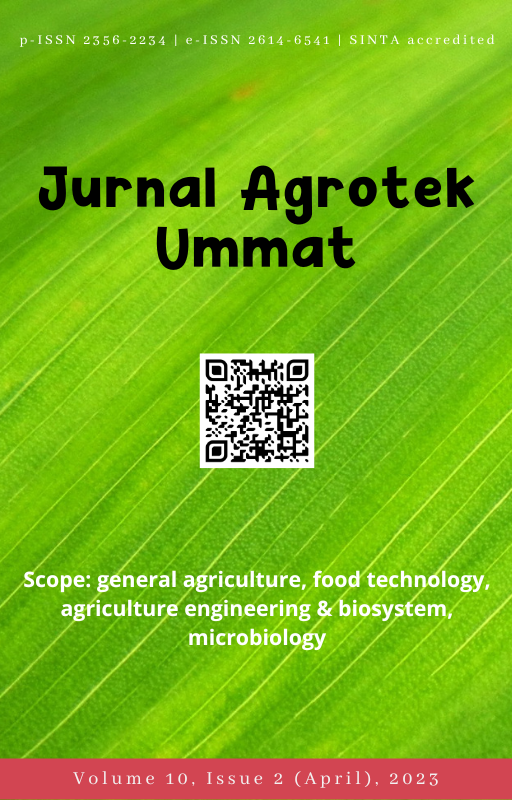Adaptation of several types of upland rice to aluminum stress and blast disease on Ultisols in Lampung Province
DOI:
https://doi.org/10.31764/jau.v10i2.14046Keywords:
aluminum stress, neck blast, strain, ultisol, upland riceAbstract
Ultisol soil has a high aluminum content and is often attacked by blast disease, which inhibits the growth and production of upland rice plants. This study aims to obtain varieties and lines of upland rice tolerant to aluminum stress and blast disease planted on Ultisol Lampung. The study used a randomized complete block design (RCBD) with 8 types of lines and 4 varieties; The experiment was repeated three times. The results showed that line 2 (PL47)-7 was better than the other lines as indicated by productive tillers of 16.8 stems, flowering age of 50% (72.12 days), number of filled grains per panicle of 75.56 grains, the weight of 100 grains of 2.70 g, yield per harvest plot of 172.51 g/ 10 m2, Aluminum stress has a score of 3 with normal growth indicators, but there are white or yellow spots on the tips of old leaves (20–39%), and neck blast has no symptoms with a score of 0.
References
Ardiansyah, R., & Jaya, R. (2021). Respon Pertumbuhan dan Produktivitas Dua Varietas Padi (Oryza sativa L.) pada Sistem Tanam Mekanis dan Manual. Jurnal Agronomi Indonesia (Indonesian Journal of Agronomy), 49(2), 147–153.
Balié, J., & Valera, H. G. (2020). Domestic and international impacts of the rice trade policy reform in the Philippines. Food Policy, 92, 101876.
BBPADI. (2018). Padi Gogo Potensi Hasil Tinggi. http://www.bbpadi.litbang.pertanian.go.id
Chandio, A. A., Magsi, H., & Ozturk, I. (2020). Examining the effects of climate change on rice production: case study of Pakistan. Environmental Science and Pollution Research, 27, 7812–7822.
Chatterjee, U., & Majumdar, S. (2022). Impact of land use change and rapid urbanization on urban heat island in Kolkata city: A remote sensing based perspective. Journal of Urban Management, 11(1), 59–71.
Gallo-Franco, J. J., Sosa, C. C., Ghneim-Herrera, T., & Quimbaya, M. (2020). Epigenetic control of plant response to heavy metal stress: A new view on aluminum tolerance. Frontiers in Plant Science, 11, 602625.
International Rice Research Institute. (1996). Standard Evaluation System for Rice. https://www.irri.org
IRRI. (2002). Standard Evaluation System for Rice (SES). https://www.irri.org/
Kurniawati, N., & Priyadi, F. (2021). Pengaruh Aplikasi Abu Terbang dan Pupuk Kotoran Sapi terhadap Populasi Mikroorganisme di Tanah Ultisol. Agriprima : Journal of Applied Agricultural Sciences, 5(1), 41–49. https://doi.org/10.25047/agriprima.v5i1.406
Lechner, A. M., Baumgartl, T., Matthew, P., & Glenn, V. (2016). The impact of underground longwall mining on prime agricultural land: a review and research agenda. Land Degradation & Development, 27(6), 1650–1663.
Lusmaniar, L., Oksilia, O., & Nera, K. (2022). Application of rice husk biochar and a combination of urea, SP 36 and KCl on yield components and yields of glutinous corn (Zea mays Ceratina) on ultisols. Jurnal Agrotek Ummat, 9(1), 26–34.
Magfiroh, N., Lapanjang, I. M., & Made, U. (2017). Pengaruh jarak tanam terhadap pertumbuhan dan hasil tanaman padi (Oryza sativa l.) pada pola jarak tanam yang berbeda dalam sistem tabela. AGROTEKBIS: E-JURNAL ILMU PERTANIAN, 5(2), 212–221.
Mondal, S., & Borromeo, T. H. (2016). Screening of salinity tolerance of rice at early seedling stage. Journal of Bioscience and Agriculture Research, 10(01), 843–847.
Mwende Muindi, E. (2020). Effects of liming on dithionate and oxalate extractable aluminium in acid soils. Asian Journal of Soil Science and Plant Nutrition, 5(3), 1–9.
Sabaruddin, S., & Rahmawati, M. (2016). Pertumbuhan dan produktivitas beberapa galur tanaman padi (Oryza sativa L.) pada musim tanam gadu. Jurnal Ilmiah Mahasiswa Pertanian, 1(1), 124–137.
Saragih, S. H. Y., Bayu, E. S., & Bangun, M. K. (2013). Karakter Vegetatif dan Generatif Beberapa Varietas Padi Sensitif Aluminium. AGROEKOTEKNOLOGI, 1(4).
Tyagi, W., Yumnam, J. S., Sen, D., & Rai, M. (2020). Root transcriptome reveals efficient cell signaling and energy conservation key to aluminum toxicity tolerance in acidic soil adapted rice genotype. Scientific Reports, 10(1), 4580.
Yuan, J., Wang, X., Zhao, Y., Khan, N. U., Zhao, Z., Zhang, Y., Wen, X., Tang, F., Wang, F., & Li, Z. (2020). Genetic basis and identification of candidate genes for salt tolerance in rice by GWAS. Scientific Reports, 10(1), 1–9.
Zhang, Q., Chen, H., Huang, D., Xu, C., Zhu, H., & Zhu, Q. (2019). Water managements limit heavy metal accumulation in rice: Dual effects of iron-plaque formation and microbial communities. Science of the Total Environment, 687, 790–799.
Downloads
Published
Issue
Section
License
Authors who publish articles in Jurnal Agrotek Ummatagree to the following terms:- Authors retain copyright of the article and grant the journal right of first publication with the work simultaneously licensed under a CC-BY-SA or The Creative Commons Attribution–ShareAlike License.
- Authors are able to enter into separate, additional contractual arrangements for the non-exclusive distribution of the journal's published version of the work (e.g., post it to an institutional repository or publish it in a book), with an acknowledgment of its initial publication in this journal.
- Authors are permitted and encouraged to post their work online (e.g., in institutional repositories or on their website) prior to and during the submission process, as it can lead to productive exchanges, as well as earlier and greater citation of published work (See The Effect of Open Access).

